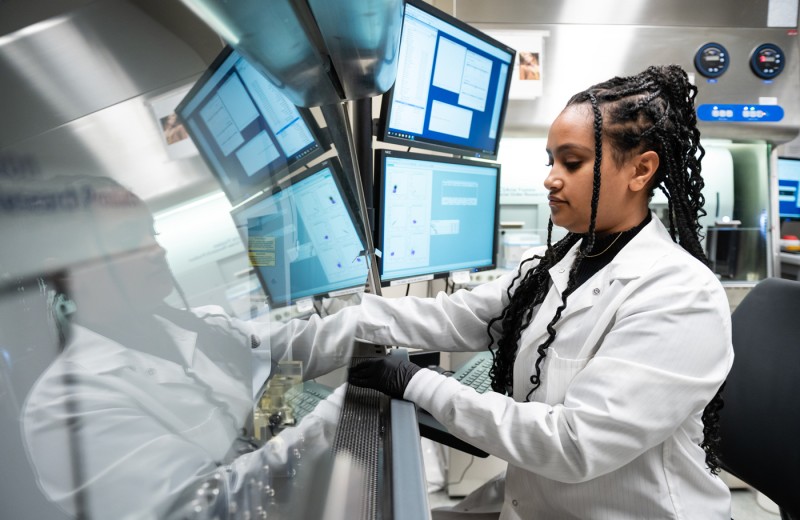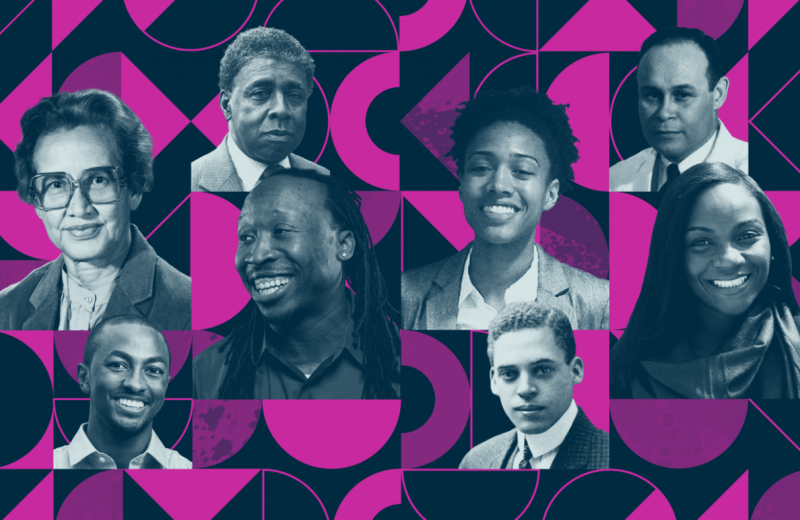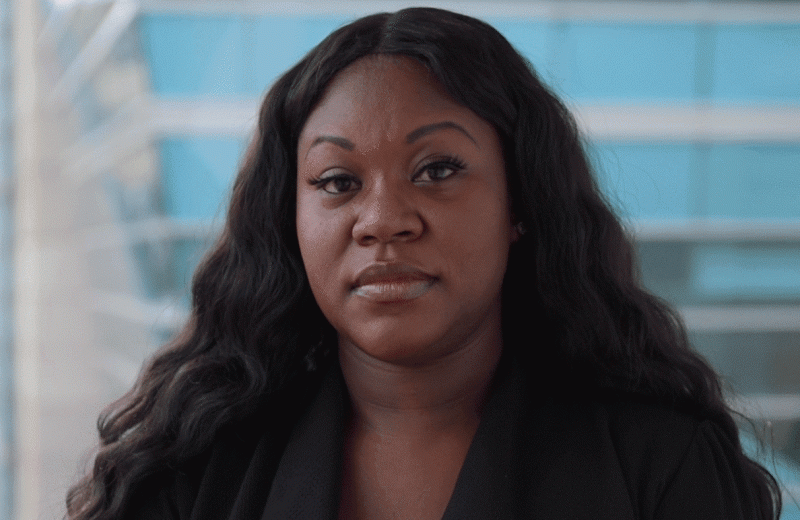Gladstone NOW: The Campaign Join Us on the Journey✕

These Latinx scientists are innovators in their fields. Top row (left to right): France Córdova, Lydia Villa-Komaroff, Carlos Juan Finlay, Anabella Villalobos. Middle row (left to right): Juan Maldacena, José Celso Barbosa, Helen Rodríguez-Trías. Bottom row (left to right): Sarah Stewart, Susana López Charretón, Ellen Ochoa, Mario Molina.
Latinx Heritage Month takes place each year from September 15 to October 15. Many great Latinx scientists are people you may have never learned about in school. From groundbreaking biologists and physicists to innovators in the fields of medicine, botany, and environmental studies, here are a few game-changing Latinx scientists that you should know.
Albert Baez (1912–2007)
Albert Baez is the father of singers Joan Baez and Mimi Fariña, as well as a Mexican-American physicist who co-invented the X-ray reflection microscope. This microscope allows scientists to examine living cells. Although he created the device in 1948, it’s still a crucial scientific tool to this day.
A pacifist, Baez refused a series of defense industry positions during the Cold War arms race and instead conducted research and taught physics at multiple institutions including the University of the Redlands, Baghdad University, Massachusetts Institute of Technology (MIT), and Harvey Mudd College.
José Celso Barbosa (1857–1921)
José Celso Barbosa was a Puerto Rican physician, professor, and politician, who is known as the father of the statehood movement in Puerto Rico. In 1875, he was one of the first Afro Puerto Ricans to graduate from the Seminario Conciliar de San Ildefonso. Two years later, he applied to the College of Physicians and Surgeons, now Columbia University Medical School, and was rejected due to racism.
He then attended the University of Michigan, becoming the institution’s first Puerto Rican student, graduating with a medical degree and acting as class valedictorian in 1880. He was the first Puerto Rican, and first Afro Latino, to earn a medical degree in the continental United States.
As a doctor, he served poor and Black communities in Puerto Rico. He introduced the concept of employers paying a fee for the health care needs of their employees—an early health insurance system.
Susana López Charretón (1957–Present)
Susana López Charretón is a Mexican virologist who gained international recognition for her work on rotavirus—a highly contagious virus that most commonly affects children. Her most important research on rotavirus identified the ways in which the virus enters the body.
France A. Córdova (1947–Present)
Astrophysicist France A. Córdova, is the director of the National Science Foundation, a US federal agency that develops programs to advance all fields of scientific discovery. She was nominated for the position in 2014 by President Barack Obama. Before that, she spent her days overseeing America’s science and scientific education programs. Córdova conducted important research on x-ray and gamma ray sources, accretion discs, and black holes, publishing more than 150 scientific papers. Back in 1993, she also became the first woman to hold the position of NASA chief scientist. Her mother was Irish-American and her father was Mexican-American. During her undergraduate studies, she conducted research in a Zapaotec community in Oaxaca, Mexico.
Carlos Juan Finlay (1833–1915)
Carlos Juan Finlay was a Cuban-born doctor and scientist, who is now recognized as a pioneer in the study of yellow fever. But back in 1881, when Finlay first presented his extensive research to Havana’s Academy of Sciences, suggesting that mosquitoes transmitted the yellow fever, he became a laughingstock. According to Finlay’s son, the research was greeted initially with silence, and then followed by “universal ridicule.” It took another two decades before his hypothesis became widely accepted. During that time, Finlay didn’t give up on his research. Instead, he spent those 20 years refining his theory, breeding mosquitoes, and conducting hundreds of tests to support this theory.
Juan M. Maldacena (1968–Present)
Born in Buenos Aires in 1968, physicist Juan M. Maldacena studies the relationship between quantum gravity and quantum field theories. Currently, he is a faculty member at the Institute for Advanced Studies. Maldacena was awarded the Fundamental Physics Prize in 2012 and appeared on the “Einstein’s Dream” episode of PBS’s Big Ideas.
Maldacena’s research on the duality of conjecture was so groundbreaking, the participants of a 1998 string theory conference wrote a song to honor him called “The Maldacena” (sung and danced to the tune of “The Macarena.” It was the 1990s, after all!). While much of Maldacena’s work is tough reading for non-physicists, he has also written several explanations of his work on quantum theory for general audiences, including a popular 2007 Scientific American article tantalizingly entitled “The Illusion of Gravity.”
Ynes Mexia (1870–1938)
Mexican American botanist Ynes Mexia discovered two new plant genera and 500 new plant species—and she didn’t even start collecting plants until she was 51 years old. Born in 1870 in Washington D.C. to a Mexican diplomat father, Mexia spent many years as a social worker before enrolling as an undergraduate student at UC Berkeley, where she discovered her passion for botany. In the 1910s and 1920s, she traveled thousands of miles around Mexico, South America, and Alaska collecting some 145,000 plant specimens in just 13 years. Today, 50 plant species are named for her.
Mario J. Molina (1943–2020)
The first Mexican-born scientist to win a Nobel Prize in Chemistry, Mario Molina discovered the serious environmental threat posed by chlorofluorocarbon gases. Along with fellow chemist Sherwood Rowland, Molina found that these gases—which are chemicals commonly used as refrigerants, and colloquially known as Freon—released into the atmosphere were contributing to ozone depletion.
Ellen Ochoa (1958–Present)
In 1993, astronaut Ellen Ochoa became the first Hispanic woman to go to space. She first served on a 9-day mission aboard the space shuttle Discovery, where she and a team of astronauts studied the Earth’s ozone layer. She has returned to space three more times since and has spent nearly 1,000 hours in orbit. Today, Ochoa, who holds NASA’s Distinguished Service Medal, serves as the director of the Johnson Space Center in Houston, Texas.
Sarah Stewart (1905–1976)
Sarah Stewart was a Mexican American microbiologist whose research showed that viruses could cause cancer. This discovery led to the development of vaccines to protect against certain kinds of cancer, like the HPV vaccine. She was born in Mexico to a Mexican mother and an American father, but her family was forced to leave due to the Mexican revolution.
Helen Rodríguez Trías (1929–2001)
Born in New York City in 1929, Puerto Rican American pediatrician and health care advocate Helen Rodríguez Trías helped improve access to public health services for women and children in both the United States and Puerto Rico. She was the first Hispanic president of the American Public Health Association, as well as a founding member of the Committee to End Sterilization Abuse, an organization that fought against the practice of forced sterilization. In 2001, she was awarded the Presidential Citizens Medal for her work on behalf of people living with HIV and AIDS.
Lydia Villa-Komaroff (1947–Present)
Lydia Villa-Komaroff is a biologist whose research on recombinant DNA uncovered a way to use bacteria cells to make insulin. She is also the co-founder of The Society for the Advancement of Chicanos/Hispanics and Native Americans in Science (SACNAS), an organization dedicated to increase the success of Chicano, Hispanic, and Native American students in receiving advanced degrees, careers, and leadership positions in STEM fields. Notably, Villa-Komaroff was only the third Mexican American woman in the United States to receive a doctorate in science.
Anabella Villalobos (Present)
Anabella Villalobos is a Panamanian medicinal chemist and senior vice president of Biotherapeutic and Medicinal Sciences at Biogen. She received her BS in chemistry from the University of Panama. In 1987, she earned her PhD at the University of Kansas. Villalobos contributed to the Acetylcholinesterase Inhibitor program which led to the development of Icopezil, a drug that advanced to Phase II clinical trials for Alzheimer’s disease.
Want to Join the Team?
Our people are our most important asset. We offer a wide array of career opportunities both in our administrative offices and in our labs.
Explore CareersProfessional Journeys of Black Gladstonians
Professional Journeys of Black Gladstonians
Get to know our Gladstone community during Black History Month
Profile Elevated Voices DiversityHighlighting Black Scientists from Past to Present
Highlighting Black Scientists from Past to Present
Featuring Black scientists throughout history
Elevated Voices DiversityMeet Gladstone: Nicole Velasquez
Meet Gladstone: Nicole Velasquez
Nicole Velasquez shares why she loves working at Gladstone, the importance of Black History Month, and how she spends her time outside of work
Elevated Voices Profile Diversity



